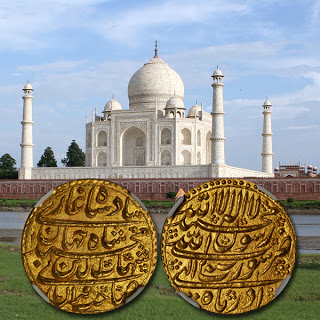
The man in whose name this coin was struck was both a successful warrior during his father’s reign and patron of the arts during his own. Shah Jahan’s father, the Emperor Jahangir, had carried out campaigns against the Mewar and the Deccan Sultanates. In these campaigns Shan Jahan led his father’s armies to victory, accounting for much of the territorial gains in the reign of Jahangir. For these successes Jahangir gave his son the title Shah Jahan Bahadur which means, “Brave King of the World”. These victories allowed the young prince to accumulate favor with his father and eventually led to his promotion as the leader of 30,000 troops and a seat near the Emperor at court. Mughal royal succession however was a complex affair in which princes from various wives would compete for power and favor. This system brought Shah Jahan into contention with his father’s most adept wife Nur Jahan in 1622. After disobeying her orders to retake Kandahar from the Persians who had recently occupied the city, the young prince was stripped of his rank. In 1626 after a four year rebellion he was forced to flee to lands in the south. It was in this pseudo exile that Sha Jahan learned of his father’s death in 1627 and hence marched to Agra to ascend the Mughal throne.
During this same period Shah Jahan, then known as Prince Khurram, was betrothed to the daughter of a Persian noble, whom he later married as his third wife in 1612. It was this marriage which would leave the most lasting marks of Shah Jahan’s legacy on the world stage. It is clear from contemporary accounts that the relationship between these two was more than a political pairing; it was a love affair. Known as a collector of jewels and an admirer of arts, Shah Jahan gave his wife the title Mumtaz Mahal meaning “Jewel of the Palace”. While on military campaigns she would accompany the Prince and amazingly bore him 14 children, including the future Emperor Aurangzeb. Sadly Mumtaz Mahal died during the birth of the pairs’ 14th child in 1631. Upon her death the Emperor then made plans for a spectacular monument to house her remains. Construction on the Taj Mahal began the next year and took a total of 20 years to complete, the main mausoleum structure was completed in 1648, while the surrounding gardens and structures requiring an additional five years to complete. The seminal example of Muslim architecture in India, the Taj Mahal is regarded as one of the most beautiful structures ever built. It is the crowning achievement of Shah Jahan’s expansive architectural projects throughout his reign.
As had happened with his ascension the indirect method of succession led to squabbling amongst Shah Jahan’s sons. After the Emperor fell ill in 1658 his son Dara Shikioh assumed the throne as regent. This incurred the wrath of his three brothers and lead to his defeat by Aurangzeb at the Battle of Samugarh. Having bested his brothers (all of those involved having been sons of Mumtaz Mahal) Aurangzeb declared Shah Jahan incompetent to rule and had him placed under arrest in Agra Fort. He remained there for the next eight years. According to legend, during the deposed Emperors final moments, he fixed his gaze on the Taj Mahal until his death. After his passing Shah Jahan was buried in the Taj Mahal alongside his jewel Mumtaz Mahal.
From this grand period of Indian history we bring to auction a stunning gold Mohur of Shah Jahan’s second year (1628/9). Struck in the style which pervaded Muslim coinage of the era this piece stands above most with its excellent centering, evident beaded border and well struck inscriptions. An unknown date of the Surat mint until the discovery of the Akola hoard this coin also carries a deeper sense of history as along with all of its counterparts it was lost for centuries only to reappear and reaffirm the grandeur of its time. Fully lustrous and very choice this coin is a delight to behold, completely worthy of its grade of NGC MS 65. Look for this rarity and many more at the Stack’s Bowers & Ponterio Official Auction of the 2012 ANA Convention in Philadelphia.





